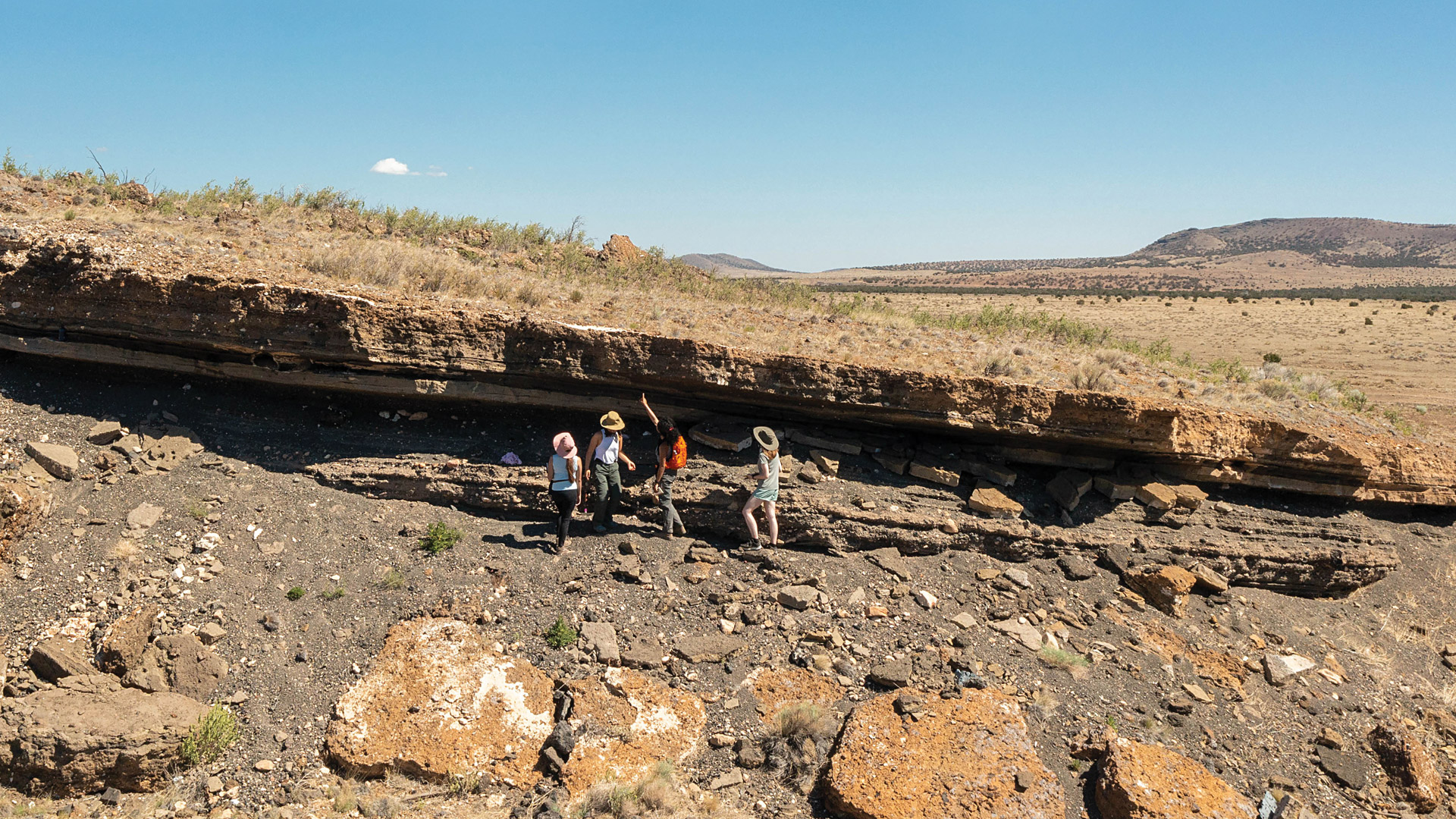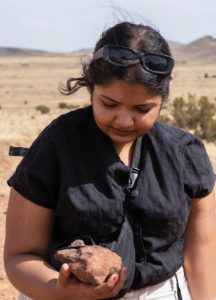The drone wouldn’t fly. The wheelchair-accessible van spun its tires, digging into the dusty gravel. And the men with shotguns refused to leave.
Standing under the baking Arizona sun, Anita Marshall took a breath. Over the past week, she had overcome international travel disasters, technology struggles, wildfires, even interference from a pair of nesting eagles, to provide hands-on experience for aspiring scientists whose disabilities excluded them from traditional field courses. Now her students had assembled on the edge of a 400-foot crater outside Flagstaff, eager for what some had been told they’d never have.
Conferring with her team of instructors, Marshall, a University of Florida geologist, reboots the drone. A delegation convinces the men using the site for target practice to move to a different area. The marooned van will have to wait, because the 18 students — some here in the desert, some joining remotely — are keen to do some science.
“They need this. If they don’t have experiences like this, we’ll lose some amazing minds out of our field,” Marshall says. “I don’t want that to happen.”

If you care about clean water, climate change, energy, sustainable agriculture or other areas that rely on earth scientists, neither should you, Marshall argues. But earth science degrees often require a physically taxing, six-week camping trip far from medical care and even electricity. It’s a deal breaker, not only for those with mobility limitations, but also chronic fatigue, digestive issues, even severe food allergies — not to mention family or work responsibilities that prevent them from disappearing into the wilderness for half the summer.
With a $440,149 grant from the National Science Foundation, she launched GeoSPACE, an accessible field camp that’s opening geosciences — the least diverse STEM field — to people who might not fit the mold of the mountain-scaling explorer conquering the wilderness.
That’s the very image that drew Marshall to the field, until a near-fatal accident changed her trajectory.
Now she wants to reimagine field camp from the ground up.
“I don’t want field camp to be a barrier,” she says. “I want it to be a springboard.”
People Before Rocks
The drone is finally cooperating.
“Fly my pretty, fly!” Marshall says, handing the controls to Francesca Butler, a geology student from the United Kingdom. Because Butler uses a wheelchair, she’s been excluded from fieldwork at her university. Butler says GeoSPACE’s summer 2022 pilot program has allowed her to feel “like a real geologist.”
“I was almost in tears when I was able to get out in the field for the first time,” she says. “I think this is going to be the blueprint for the future.”
After exploring the trails leading around and through the crater, Butler is getting a bird’s-eye view of an outcrop rippled with striations of red, brown and black that reveal the desert’s volcanic past. Drones are one way Marshall brings the rocks to students. She also leverages satellite imagery, live high-definition video and the messaging platform Discord to put students in the middle of the action, whether they’re exploring the outcrop, working from a high-tech base camp beneath a pop-up awning, or joining remotely from home. After a half day at the site, they’ll return to a La Quinta in Flagstaff to review their data, learn about high-precision GPS mapping, and eat a home-cooked meal that accommodates all participants’ dietary needs.
It’s the opposite of a typical field camp, where forgoing comfort — and technology — is as much a part of the experience as the science.
But as Marshall is fond of saying, the rocks don’t care if you slept in a hotel.
“Chug your water, guys, that was a lot of dry air,” Marshall says from the driver’s seat on the way back from the field site.
The 15-passenger van rattles down a washboard road, every rut reverberating in bone-jarring judders. Pebbles ping the undercarriage like popcorn in a pan. Getting out of the classroom and into wild places like this is a cornerstone of field camp, and where research shows many students start to feel like real scientists. But for students with disabilities, who represent about 20% of the undergraduate population nationwide, it can also be an enormous source of stress. If they can’t get the accommodations they need to participate, they may have to change majors. That can lead students with less-visible disabilities to hide them, putting themselves in danger — a pattern Marshall knows well from her own experience. With this trip, she’s setting out to prove that the rigor and the joy of field camp can come in an accessible package.
It took a year of planning and scouting to organize locations and logistics. Each site needs passable roads, wheelchair-friendly surfaces, strong cell service for streaming video, and proximity to accessible hotel rooms and bathrooms. If a site doesn’t offer a meaningful field experience for everyone on the trip, it doesn’t make the cut.
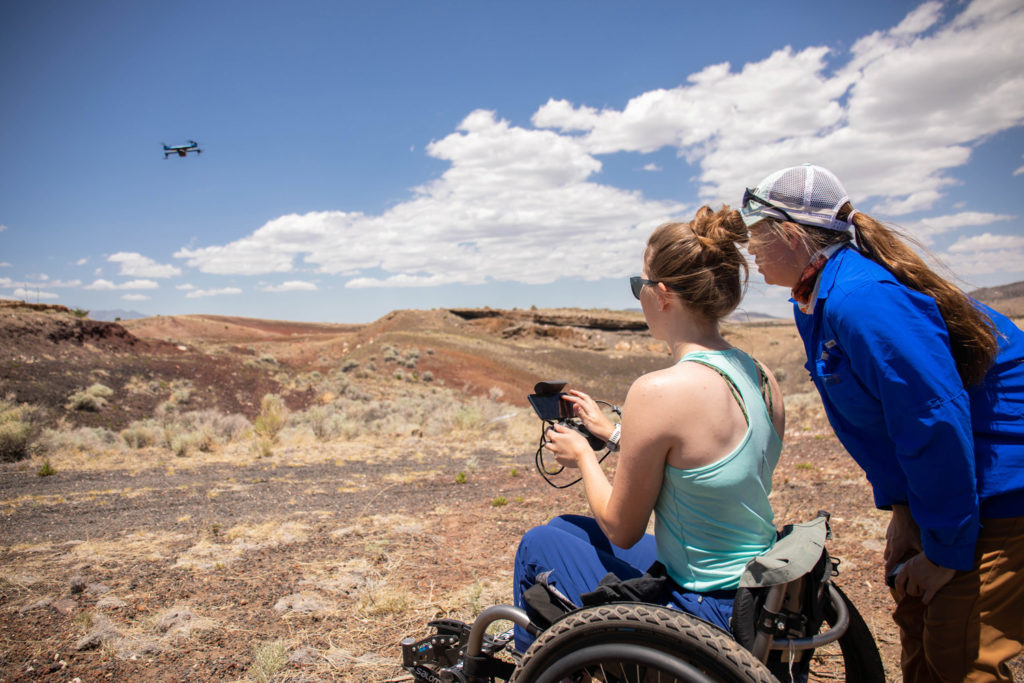
They also try not to spend more than half a day out in the elements, as their enthusiasm can tempt them to push beyond their limits — another pattern Marshall knows well. Throughout undergraduate and most of grad school, she relished the physicality of her fieldwork-heavy earth science program.
Then, on the night of her department’s awards banquet at the University of Arkansas, a drunk driver hit her as she was unloading her pickup truck. She nearly died at the scene and again at the hospital. When she regained consciousness, her left leg was crushed. So, she thought, were her dreams of becoming a field geologist.
“One of my very first thoughts when I woke up in the hospital was that my geology career was over,” she says. “I had never heard of a geologist with a disability. I didn’t see any path forward.”
A year of reconstructive surgeries followed. Her father quit his job and moved closer to campus to help. He and her sister became her field assistants, gathering data from places Marshall couldn’t access. When insurance hurdles delayed getting a wheelchair, her grandfather offered his.
“He would get himself all comfy in his recliner and I would leave for school in his wheelchair, do my classes, and then come back and give him his wheelchair back. We knew the clock was ticking to finish my master’s work. It was a big family push to get me through my degree.”
A member of the Choctaw Nation of Oklahoma, Marshall sees that community approach as central to her work in inclusion.
“Individualism is really foreign to a lot of Indigenous viewpoints, and Choctaws are no different in that. You’re always looking out for the needs of your family and your group. That very much influences my philosophy on field courses,” she says. “Rocks are cool. People are better. Take care of your people, and the rest will come.”
After graduating, Marshall learned to walk again. She got a job teaching geology at a community college. She loved it, but the repetition was very different from the far-flung places and extreme environments she had imagined. For seven years, the same introductory geology class, the same National Geographic video about volcanoes. Then one semester, something about that video jumped out at her. One of the scientists, severely injured in an eruption, had resumed his research after a long recovery.
“He’s doing it,” she recalls thinking. “Maybe I can do it!”
She started applying to Ph.D. programs, got accepted, and a year later was headed back out in the field.
Things did not go smoothly.
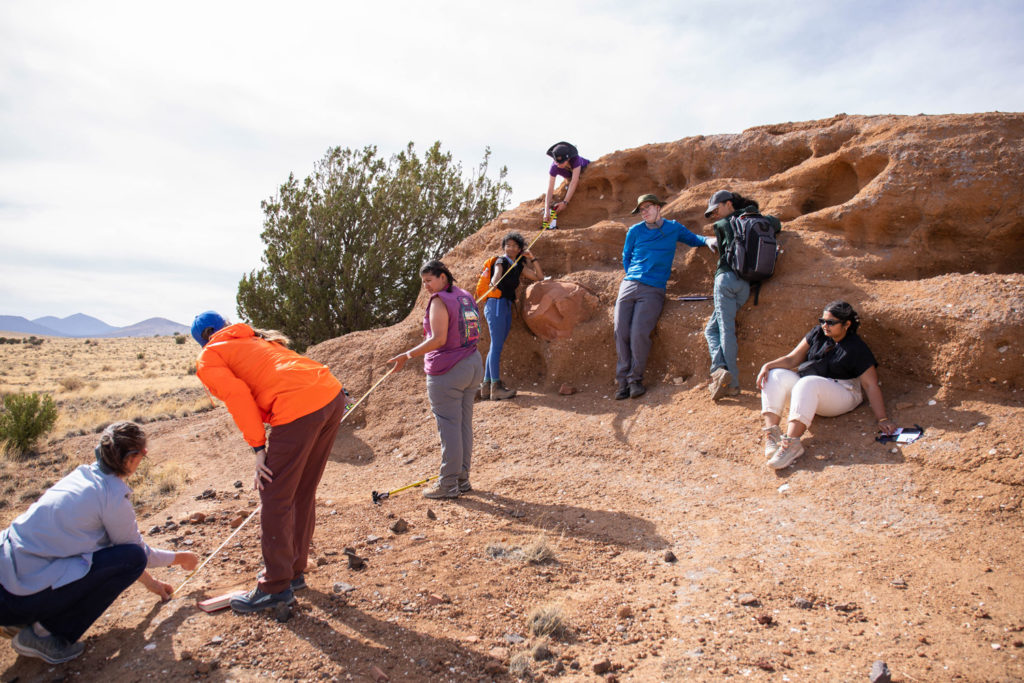
The Trouble with Field Camp
On the rim of a volcano in Nicaragua, the doctoral students gathered for a lecture about the geological features around them — all but Marshall, left straining to hear her professor from the other side of the crater. She had gone as far as her reconstructed leg and chronic fatigue allowed, farther, really, pushing beyond the point of safety, not wanting to be left behind. As her fellow students walked past her on their way back, one rolled his eyes.
“I don’t know why she even bothers,” she heard him say.
She felt alone. But when she examined her situation like a scientist, she realized she couldn’t be. In student surveys, 22% of high schoolers with disabilities say they’re interested in STEM careers. By the time they’re in undergrad, just 10% are still pursuing STEM jobs. Among master’s students, it dwindles to 6%. Marshall clearly wasn’t the only one getting the message she didn’t belong.
“The more I dug, the more I realized how little was being done and how this was a massive unspoken problem.”
Marshall knew she’d never regain the physical aptitude of able students. But with her new perspective, she started to wonder if the grueling physicality wasn’t central to the work, but merely the culture. Field camps have been slow to evolve, says Ellen Martin, UF’s geology department chair. As geosciences went high tech, field camp at many universities retained an emphasis on hand-drawn maps and physical prowess.
“There are instructors who try to make it as physically demanding as possible,” Martin says. “If that’s not the part of geology you’re going into, that’s not relevant at all.”
As a field geologist, Martin sees value in traditional field camps, but also recognizes that “we don’t all have to be men in flannel shirts with beards and rock hammers running around in the woods. Finding a way to have a more diverse field camp gives options for people who are interested in other aspects of the science.”
Although not all geoscience careers require fieldwork, many geoscience degrees do — as do employers, who may look for field experience because of the pivotal role it plays in building students’ skills, confidence and networks.
The answer, Marshall realized, wasn’t to do away with field camp, but to recenter it on skills students actually need. Without that, talented young scientists would continue to leave the field.
“It makes me die a little inside when I meet these amazing students and realize that they are being shut out of our discipline,” she says. “They’re innovative. They’re creative. They’re resourceful. We’re actively pushing them out, and that just kills me.”
The National Science Foundation agreed, funding two years of GeoSPACE as part of its mission to reach those excluded when science careers aren’t accessible or inclusive. NSF Director Sethuraman Panchanathan calls them “the missing millions.”
“We are leaving tons of our talent behind,” Panchanathan said at a visit to UF in May.
“We need all of it to unleash innovation and prosperity for all.”
Programs like Marshall’s are important for student retention and a sense of belonging and acceptance in the field, says Brandon Jones, NSF Program Director for Geosciences Education and Broadening Participation programs.
“The GeoSPACE program is using creative approaches to ensure that people with disabilities can participate fully and meaningfully in field experiences,” Jones says. “GeoSPACE involves students in developing the field experience and creates a network of mentors to support and encourage them.”
Mission: Inclusion
At the crater, teams of students fan out across the landscape, tackling the research questions they designed with the remote students. A remote option was critical to be truly inclusive, Marshall says, as some students’ disabilities won’t allow them to participate even with accommodations.
The virtual participants serve as mission control for the group, introducing each new site based on satellite data, thermal imagery and Google Earth. In-person students act as the astronauts exploring the surface of another planet, gathering data that requires closer observation. It’s an apt analogy for this otherworldly landscape, and relevant to the course’s focus on planetary geology. But at its core, it’s a strategy to ensure everyone, regardless of their level of physical participation, has an integral part in the mission.
“I know that feeling of being left at the van while everyone else goes to do cool stuff,” Marshall says. “I don’t want another student to feel like I felt.”
Rutgers student Shivani Dattani returns from a sun-scorched ridge flanking the crater, taking a moment in the shade of the van to reflect on getting her first field experience through GeoSPACE. After a personal trauma, Dattani struggled to regain her footing in academia.
“This has really helped me bridge that disconnect from the year I missed,” she says. “It’s easing me back into what I really want to be doing: academic research. I feel like there might be a space for me in the scientific community.”
After receiving more than 70 applications from around the United States and six countries, Marshall realized how many types of students also felt like outsiders.
“Not everyone in our group identifies as disabled. They come from many walks of life, many different identities, and they all feel traditional field camp is not a great place for them.”
Marshall’s goal of broadening access resonated with UF geology graduate and GeoSPACE project manager Yesenia Arroyo, who joined the team which includes UF professors Steve Elardo and Amy Williams, plus geologists from Arizona State University, Central Connecticut State University, the University of Cambridge, the U.K.’s Open University and Rutgers University.
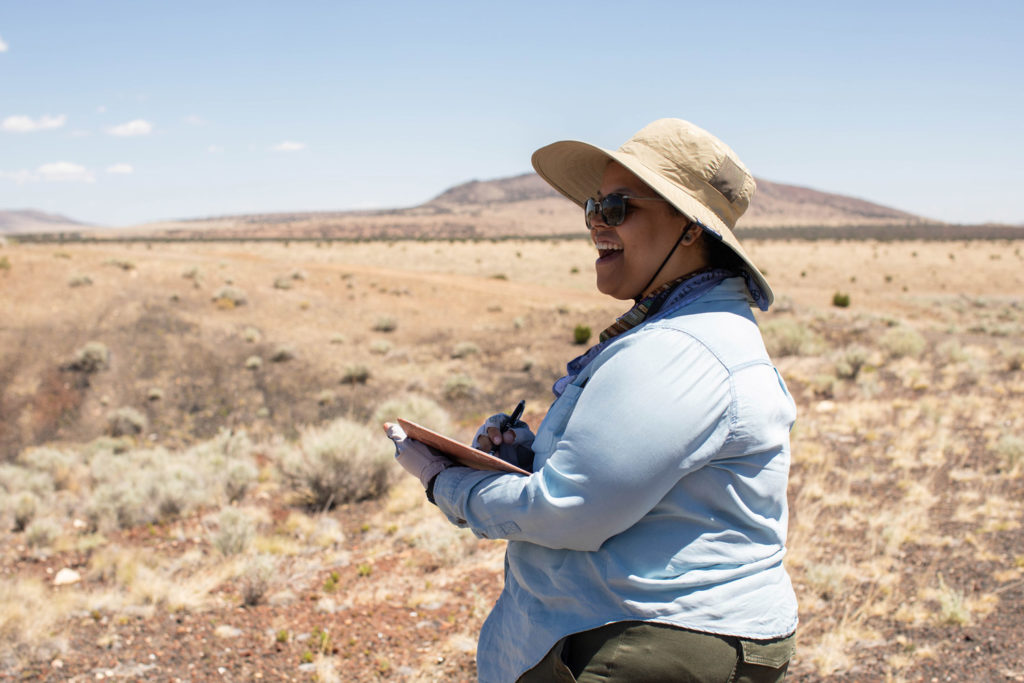
“What she was saying about accessibility really struck a chord with me as a geologist with various intersectionalities myself,” says Arroyo, who is Black and Hispanic. “She definitely has the mission to get geologists of all shapes and sizes out here. It shouldn’t be stopping you from participating in something you love.”
Unfortunately, not everyone agrees.
‘Almost a cruel joke’
In 2018, her Ph.D. complete, Marshall started looking for a faculty job. Wrapping up her presentation on inclusive fieldwork at one interview, she asked if there were any questions.
After a long silence, one professor raised his hand and asked, “Why? Why bother?”
While most people don’t say it out loud, plenty share his assumption that disabilities impact a tiny portion of geoscience students. Because many disabilities aren’t outwardly visible, faculty members might assume no one needs accommodations. Sometimes they’re right, because those who do have concluded that they’re not welcome and changed majors. When students request accommodations for fieldwork, they often face resistance, Marshall says. As executive director of the International Association for Geoscience Diversity, she hears these stories constantly from universities in the United States and beyond. For example, one student whose manual dexterity limitations made it hard to take notes asked to use a tablet in the field. The request was denied.
Beyond disability, students with young children, financial constraints, or mental health considerations can see a traditional field course as an insurmountable obstacle. Try asking your boss for six weeks off, then paying for the course while you’re not working, she says.
“It really was designed for students from a bygone era — mostly male, independent students who had the financial and social ability to disappear for six weeks. For modern students, it’s increasingly hard to do that. The financial barrier is huge. The time barrier is huge. And six weeks is a long time to go without your support network. To make that a required component to finish a degree seems like a pretty large request.”
Back at the hotel, the group gathers for a taco buffet in the lobby, still buzzing about their day in the field.
“Don’t get used to this,” Marshall laughs, referring to the allergen-safe food, the laundry facilities, the comfy beds. She knows many of these students will go back to programs that require more than she can provide. GeoSPACE puts the all-important field experience on their resume, but as a two-credit course, it can’t replace the typical six-credit requirement on its own. At UF, students can replace the traditional course with another option approved by the undergraduate coordinator. An injured student was able to fulfill the entire 6-credit requirement virtually, an option geology chair Martin says is available to others who need it. But few universities offer such alternatives, which worries Marshall.
“I don’t want to take them out to have this amazing experience, get this little glimpse of how things could be, and then kick them back to the real world where they still can’t get through their degree programs,” she says. “That would almost be a cruel joke.”
Instead, Marshall wants other universities to use GeoSPACE as a model, leveraging everything she’s learned to develop inclusive, accessible two-credit modules on different topics. UF is considering adding a two-credit option during spring break, Martin says.
“I’m amazed by the impact Anita’s already had,” she says. “It’s making a lot of people think. I suspect a lot of places will realize it’s to their benefit to offer programs like that for their students.”
If they do, we all stand to benefit.
“We can’t keep courting such a narrow sliver of humanity and then expect to tackle these big, complex problems that affect everybody,” Marshall says. “We have to move forward with all the voices. And not just for the science, but because it’s the right thing to do.”
Photos and video by Brianne Lehan/University of Florida
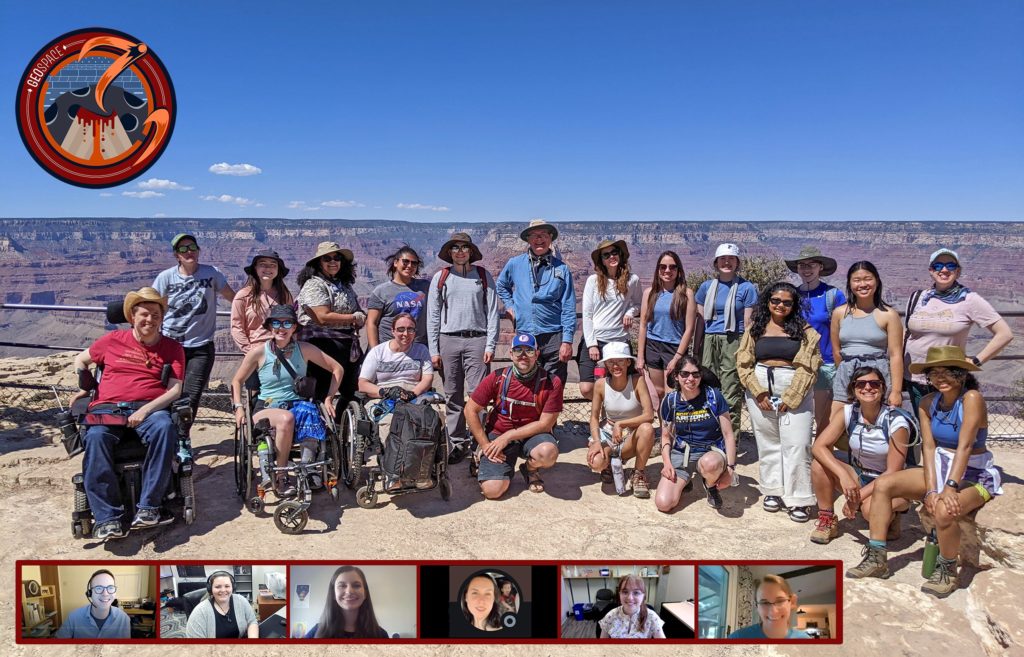
Source:
Anita Marshall
Lecturer, Geological Sciences
anita.marshall@ufl.edu
Hear the Story
The audio version of this story is available on our YouTube.

